A fireball seen by many in Western Australia, that fell deep in the bush. The DFN team went up on a plane to spot it…
Part I: Intro - The fireball
by: Hadrien Devillepoix
Sunday May 11th.
As all good fireballs, this one happened on a weekend. On this particular sunday, while I am out in the woods, the phone starts ringing. Matt from Perth Observatory breaks the news to me and asks “do you have any observations?”. There are visual reports from Perth and Leonora, which are 600km distant, meaning that this thing was seriously bright. No way to check as I am out for a mountain bike ride, on the edge of reception, and far from a laptop. I get home, barely any time for a shower and 10 minutes later the TV crew is already here. This was the beginning of two busy weeks.
I finally get to a computer, the fireball is visible in two of our DFN stations, very low on the horizon. I compute the astrometry, the lowest data points are 2° above the horizon. Both cameras are 400km+ away and form a 15° convergence angle on the trajectory. At this point confidence is not very high: I have no trust in my astrometry (we cannot see stars that low in our images); and we don’t see the end of the fireball, so we have no idea what the end height is, or at what altitudes the fragmentation happens.

There were lots of casual videos of the event, but unfortunately no fixed camera was close to the fireball. There is also a security camera in Wagin 300km, but the morning twilight combined with the camera compression eats all of the stars. We calculate a wind model anyway, and compute a first dark flight.
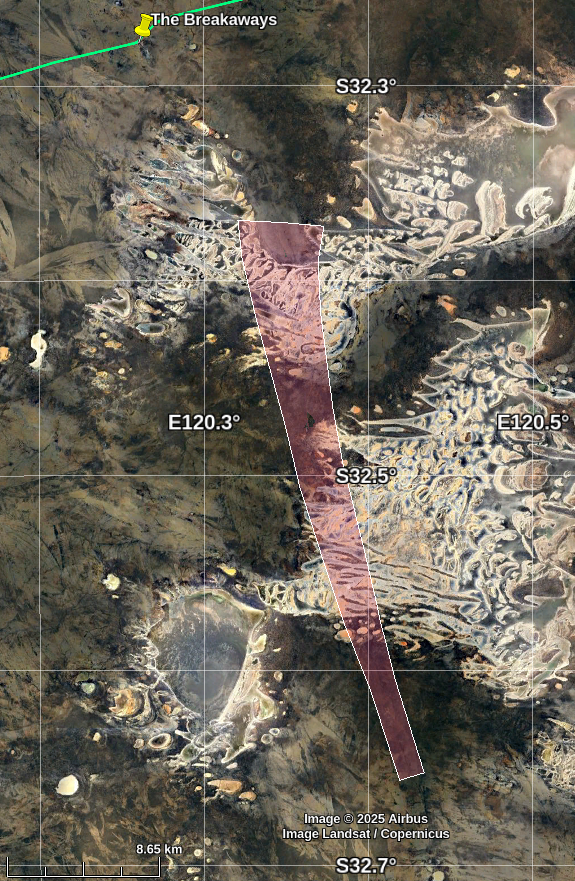
This is a big area to search for our small team. So on Monday May 12th, we make the call and release the fall area to the public,
Part II: Airborne
by: Ellie Sansom
Saturday May 17th.
After the rest of us had shrugged off the idea of searching on foot ourselves, or trying the drone, Mia asked the key question “Quite a lot of that fall line is over salt lake. It hasn’t rained yet. Could you do a Murrili and spot it from a plane?”
Well. There you have it. The higher mass end would have reached the southern lakes. We doubted that small fragments would be visible at the northern end, but figured a scout over the southern lakes would be worth a shot. It would quickly rule out any effort to get boots on the ground that’s for sure. So there was a rush to get a pilot, a plane, and approvals for it all. At 4:50pm on the Friday it all came together and Hadrien and I were set to head off first thing Saturday morning.
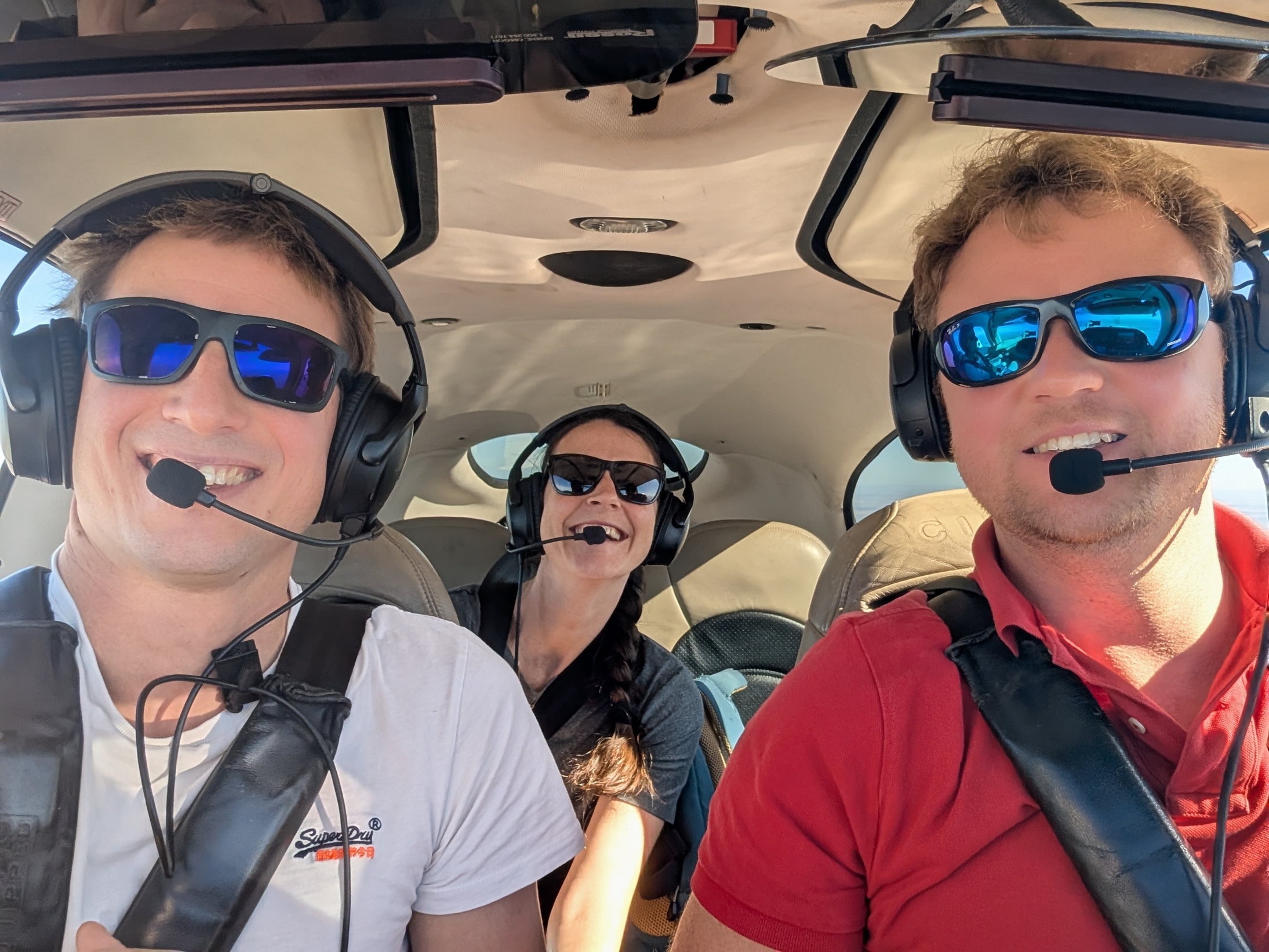
Our plane had a parachute! We headed east and chatted about meteorites and fireballs through our headsets. I was wondering if this was just a crazy idea and didn’t want to get any sort of hopes up.
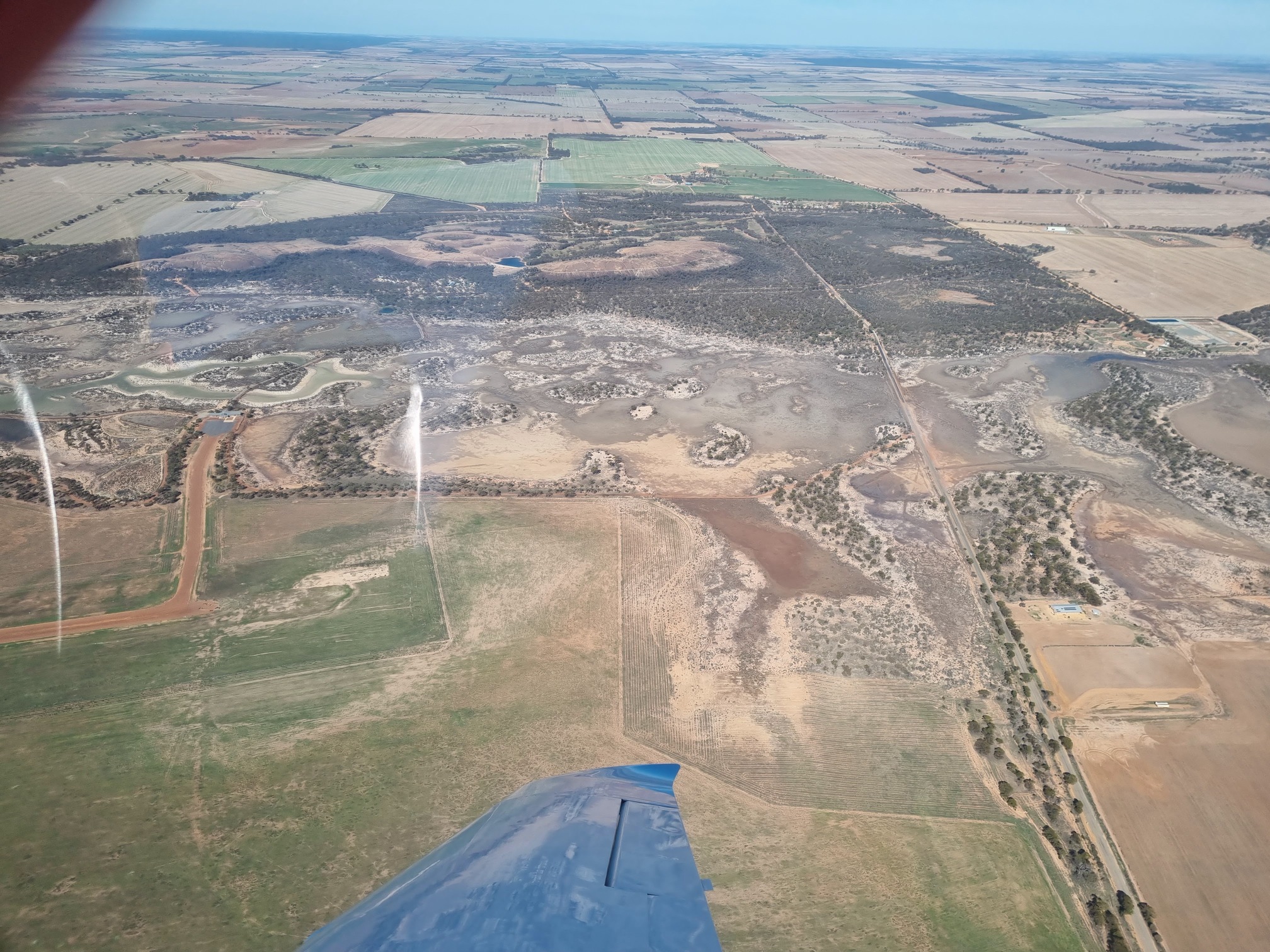
Daniel our searching pilot had come prepared for how to fly a search grid. He had downloaded an app used by tractors to seed fields in lovely rows.
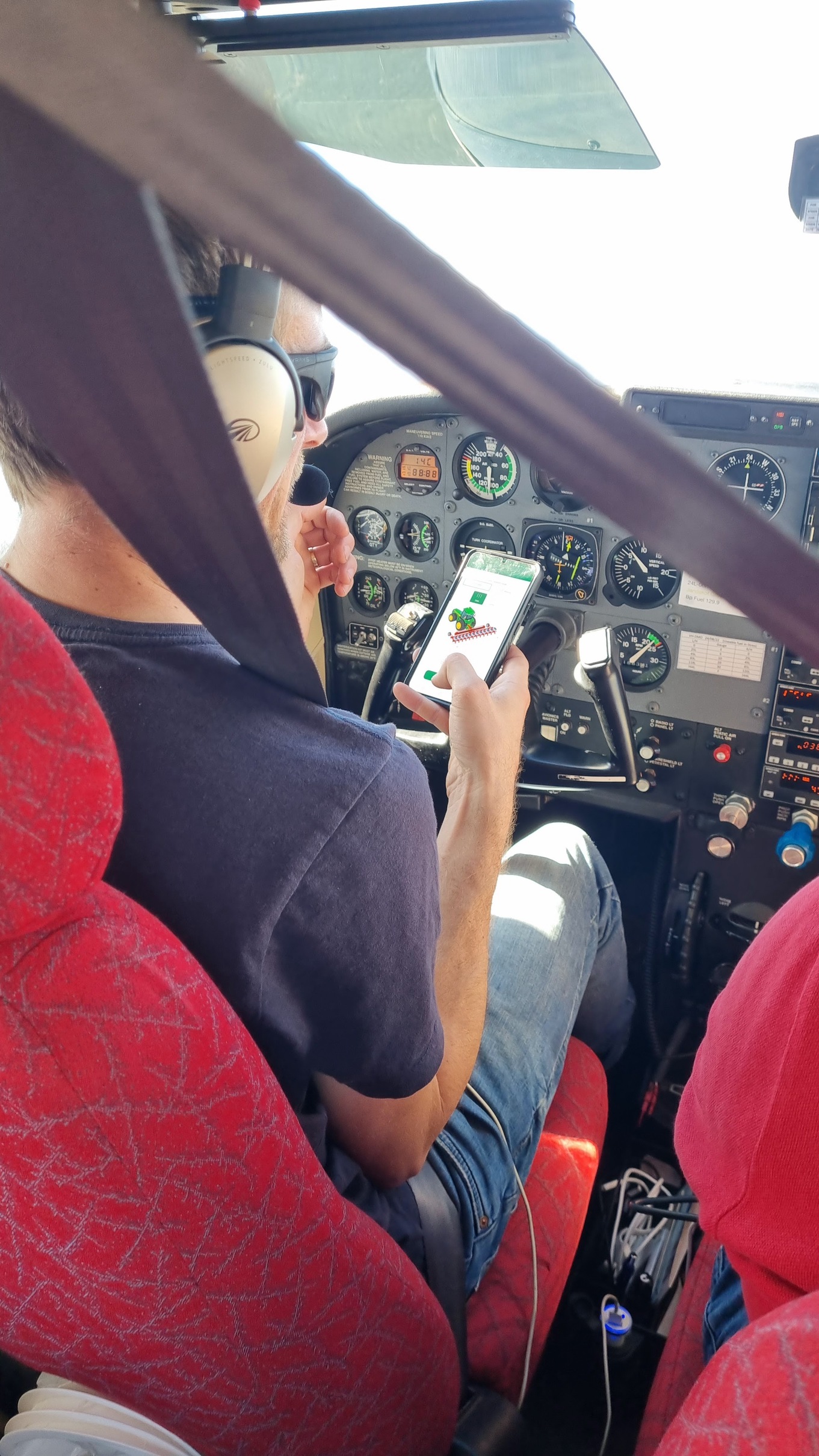
We started at the low mass end of the line, over the northern lakes. This was going to be hard! The bush in between looked searchable (turns out, it was incredibly thick and definitely not). We passed over the southern lakes. A few potential spots, and we tried to work out how to ping their positions. We were able to see the animal tracks on the lakes, so were confident anything over 100g would have left a large enough pit to be noticeable. As we got to the southern end of the line, I spotted a person walking on one of the smaller lakes. No way! Was someone actually out searching for pieces of meteorite? What else would someone be doing out here?
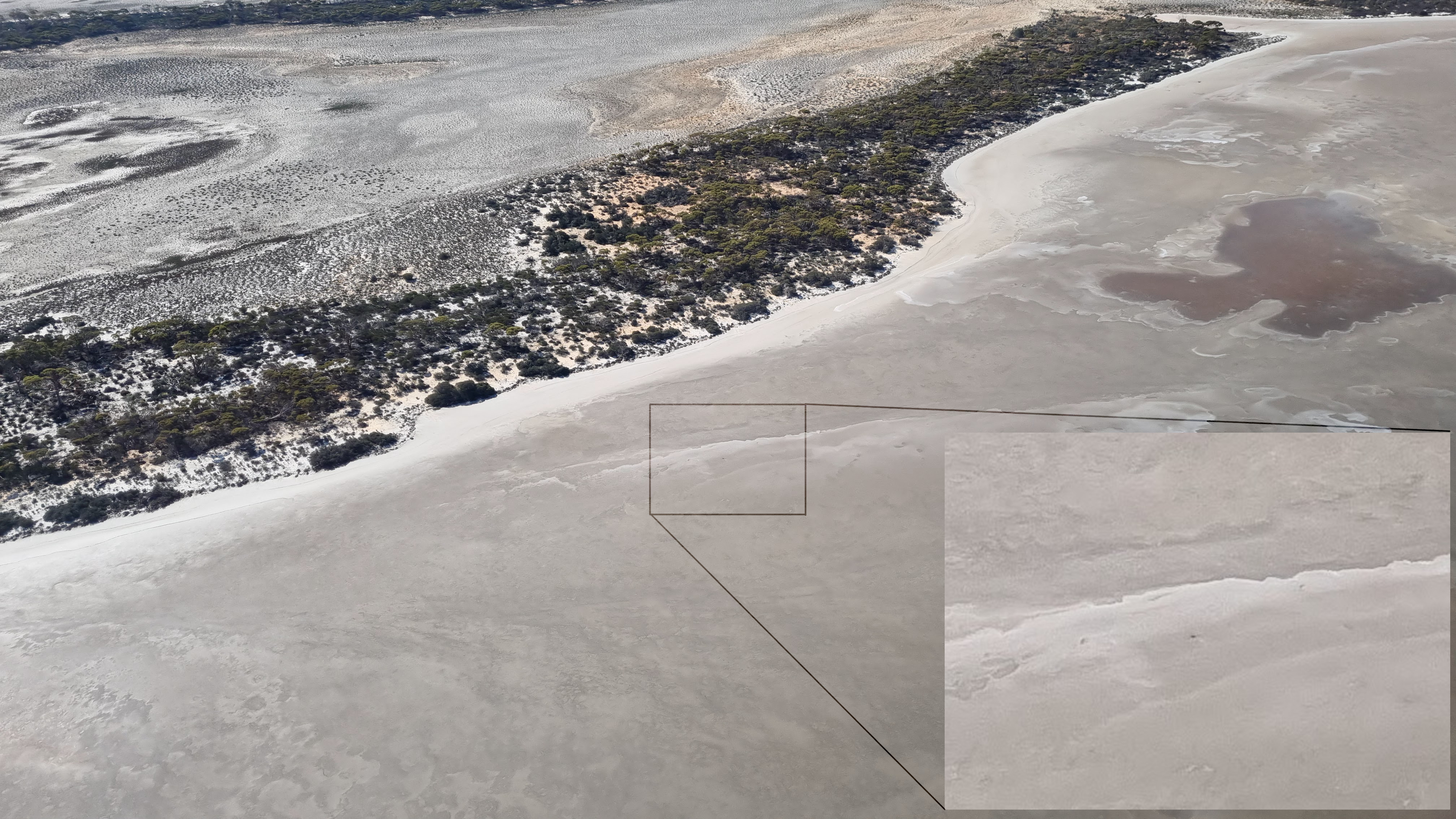
Daniel circled us around and Ondrej and I also got excited. A spot in the lake… with no other tracks… that looked like someone had taken a shovel and made a small pit, throwing the dirt off to the sides. We circled five or six times (I lost track with my nauseousness!). Looking from the east it was obvious, and easy to keep track of. From the west, it completely disappeared and took a full circle to find again.
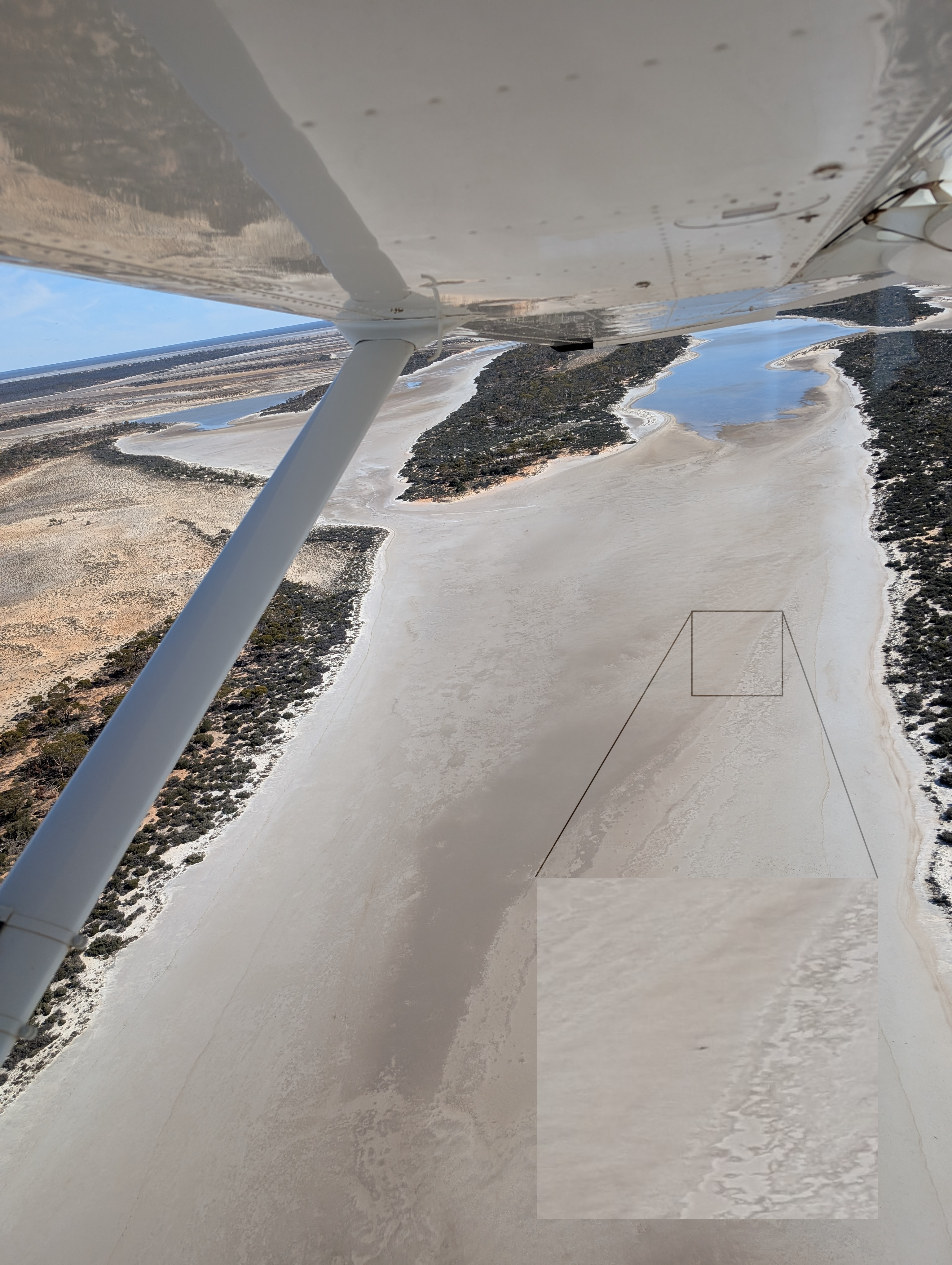
Were they both impact sites? We were all starting to feel a bit queasy by that point, so we stopped circling, climbed up above the turbulence, and scouted the tracks in. We took this opportunity to scout some other nearby fall sites to get an idea of vegetation thickness and access. One last re-visit of our potential Mother’s Day meteorite impact site before heading back. I allowed myself to actually feel excited this time! Flying back to Perth with the late afternoon sun behind us was incredible, especially with all the bush fire burn-off below us.
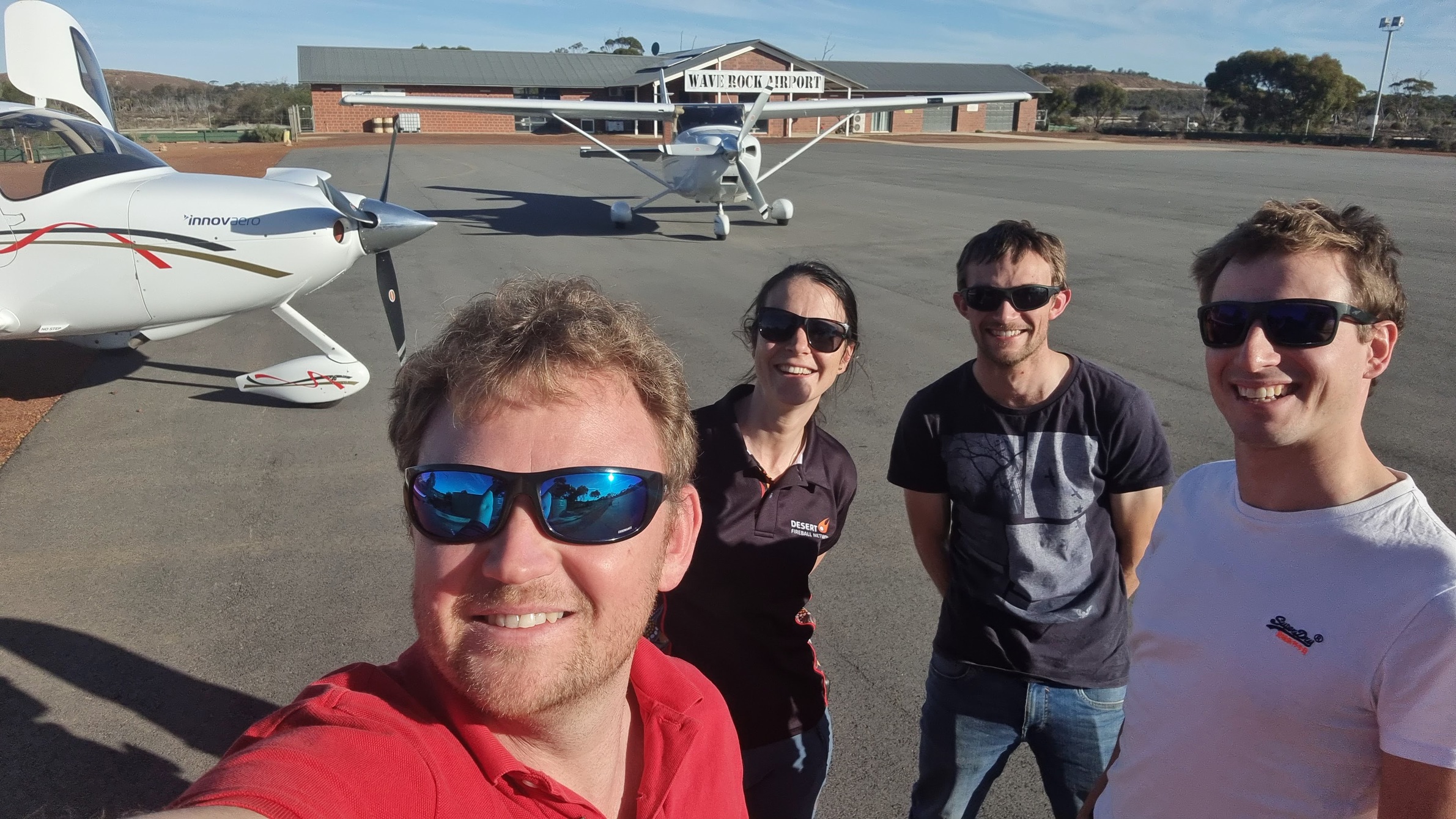
“So when are we going to pick it up? I want to go!” declared Ondrej on the way back. We started discussing how we would get out there, given all our gear and Rhonda were in the Nullarbor on the drone testing trip. Well, the next day, I woke to a facebook link sent by Rachel. The person we’d seen on the lake was Marcus, who had actually found a piece! And a big piece at that. Initial disappointment very quickly gave way to excitement. Sharing the fall area had paid off. Was it one of the sites we’d spotted? No, but he’d seen us circling so knew he was in the right area. So, the other pieces were still out there. We’d better go get them too before it rains!
Part III: Meteorite Rescue Operation
by: Hadrien Devillepoix
May 20/21th.
Sunday May 18th: the morning following our flight, we hear that Marcus has found a meteorite. This is a relief: it would not be lost to the bush after all. When we spotted the splashes from the lake I didn’t want to be too hopeful, but Marcus finding a bit gives me a sudden confidence boost: our calculations were not too bad, and these splash-looking liking like features had a very good chance of being other fragments.
Ellie and I geo-reference our airborne pictures with Google Earth. We make several sightings for the three splashes, and the estimates are falling within 150m of each other for each of the two targets. So at that point we are keen to go out again to follow up these targets, accutely aware that a couple of days later a rain front is forecast, which could erase the splashes off the lake. This basically leaves Monday to assemble a team, sort out travel approval, and pack all the gear; for what could possibly become an epic bush bash and a long muddy walk.
After the airborne mission, Ondrej is dead keen to put boots on the ground. I talk to Simon while orienteering on Sunday, who is freshly retired and up for an adventure. Mia completes our crew of four. Four is good because I can definitely see 3 people having to clear the path for the car.
To complicate things further, our trusty Land Cruiser Rhonda is out in the Nullarbor on a different mission (more on that in a later post), and with it is most of our good gear. After Dale and Iona’s recent experience in the Nullarbor with a shocking vehicle that Budget dares calling a “Mine Spec 4WD”, I am not too keen on getting a crappy rental again. Simon offers too take his Pajero, but it doesn’t feel right to take personal vehicles on a bush bash. Luckily Earth and Planetary Sciences at Curtin has a 4WD Hilux ute that is available, limited in terms of cargo capacity, but that will have to do. So I scramble on Monday to assemble the equipment: sat phone, first aid kits, leather gloves, saw, tyre plug kit, cooking kit, swags, drone, meteorite sample bags…
I get a call from Amber from channel 9, who wants to tag along to get a TV story. I explain to her the gist of the expedition, and a couple of minutes later she calls me back: she has a green light on her end.
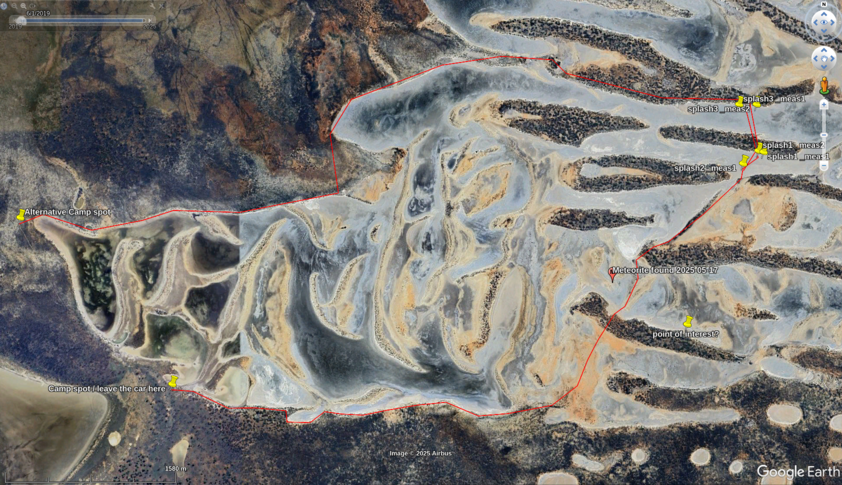
So the next morning (Tuesday) we are off. Although the drive is uneventful, we can’t help but notice how much quicker flying is (4h in the car vs 45’ on the plane). We meet Amber and Rhys from Channel 9 for lunch at the bakery. They also came with a Hilux: to me that’s peace of mind that one Hilux can became spare parts for the other! We then re-fuel: diesel and beers. Then head East on the gravel of the Hyden-Norseman road. I know Marcus has gone in from the Lake King-Norseman road, South of the lake system, but reported it was slow and overgrown. Since just getting to the main road turn off would have been 1.5h extra for us, I decide to attempt the track from the Hyden-Norseman side as it looks slightly less overgrown from the satellite imagery. After 130km, we get to the turn off where things may start getting messy.
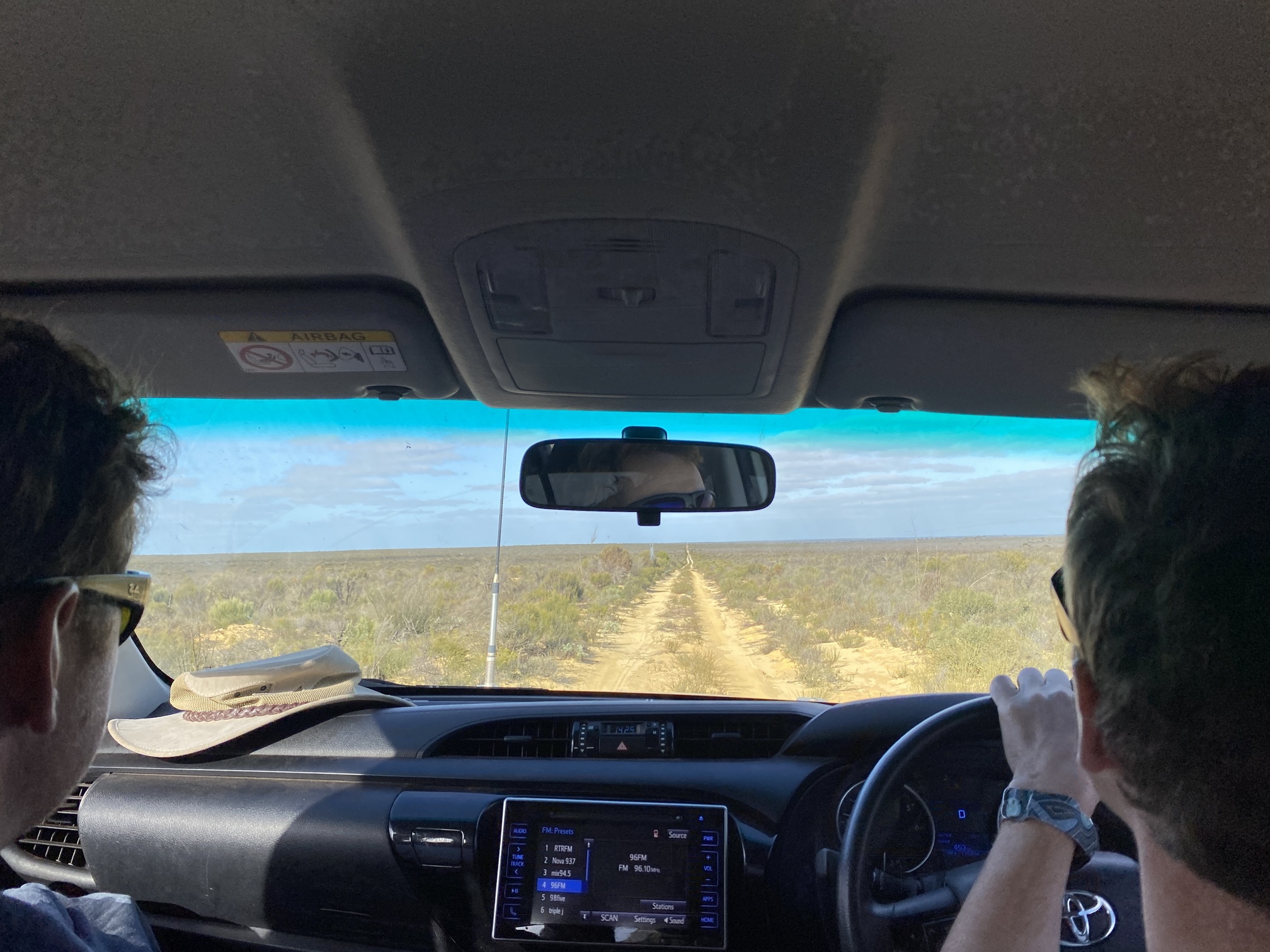
But then we start running into areas with fallen timber. I don’t want to take any chances on our 8 tyres, also knowing that we would have to drive out the same way. So we clear as much as we can in front of the car, pushing it by hand or cutting it:
We also encounter re-growth patches: the trees growing in the middle of the track are still just about soft enough that we can slowly drive over them:
We make steady progress. An eye on the clock, and we still have to drive 20km with just 1.5h before sunset. Eventually we get to my “Alternative Camp spot” on the map, that’s a relief because at this point I know we can get to the meteorites on foot, even if the cars can go no further. We press on to the nominal camp spot, and are greeted by camels 10 minutes before sunset.

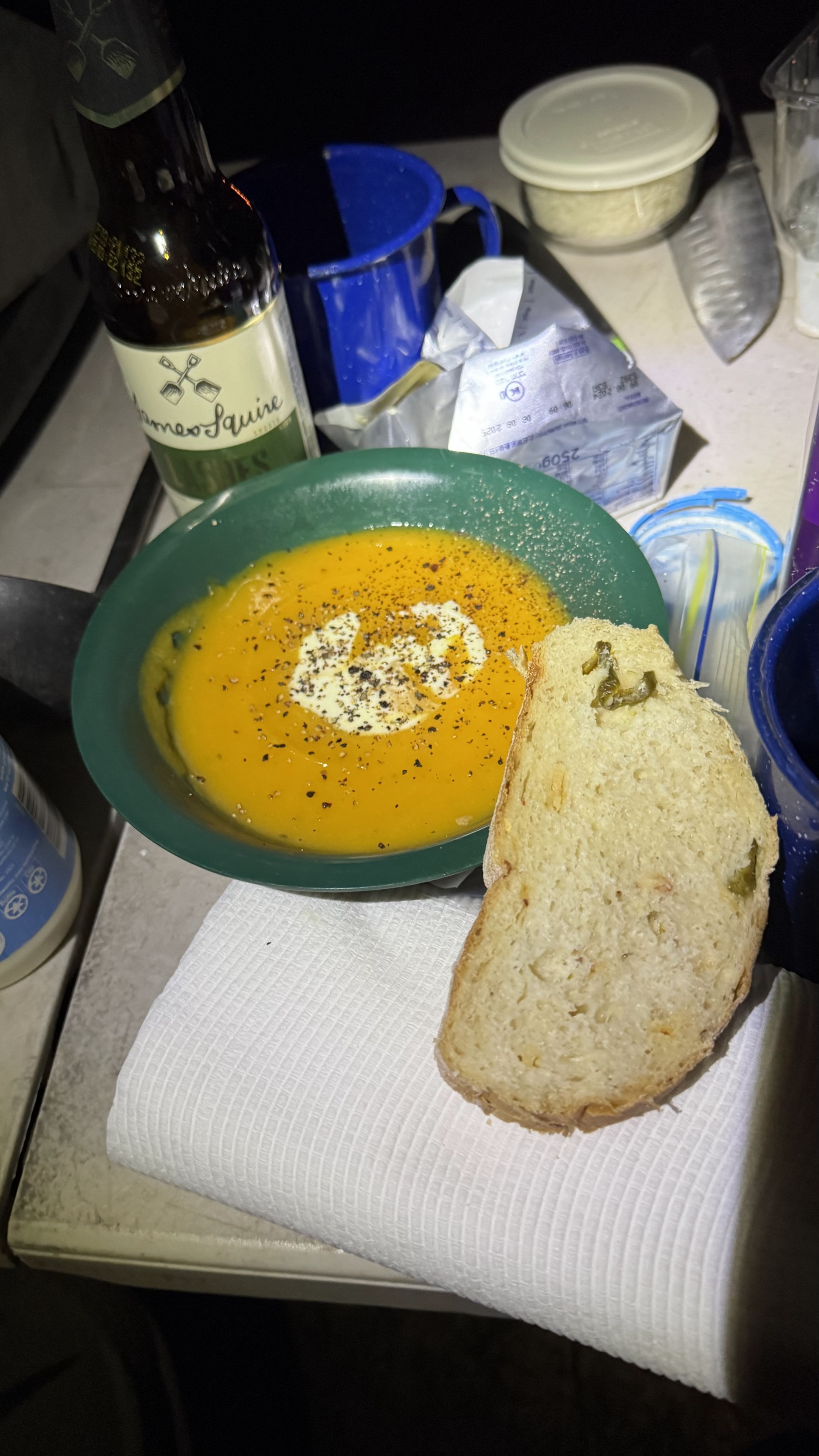
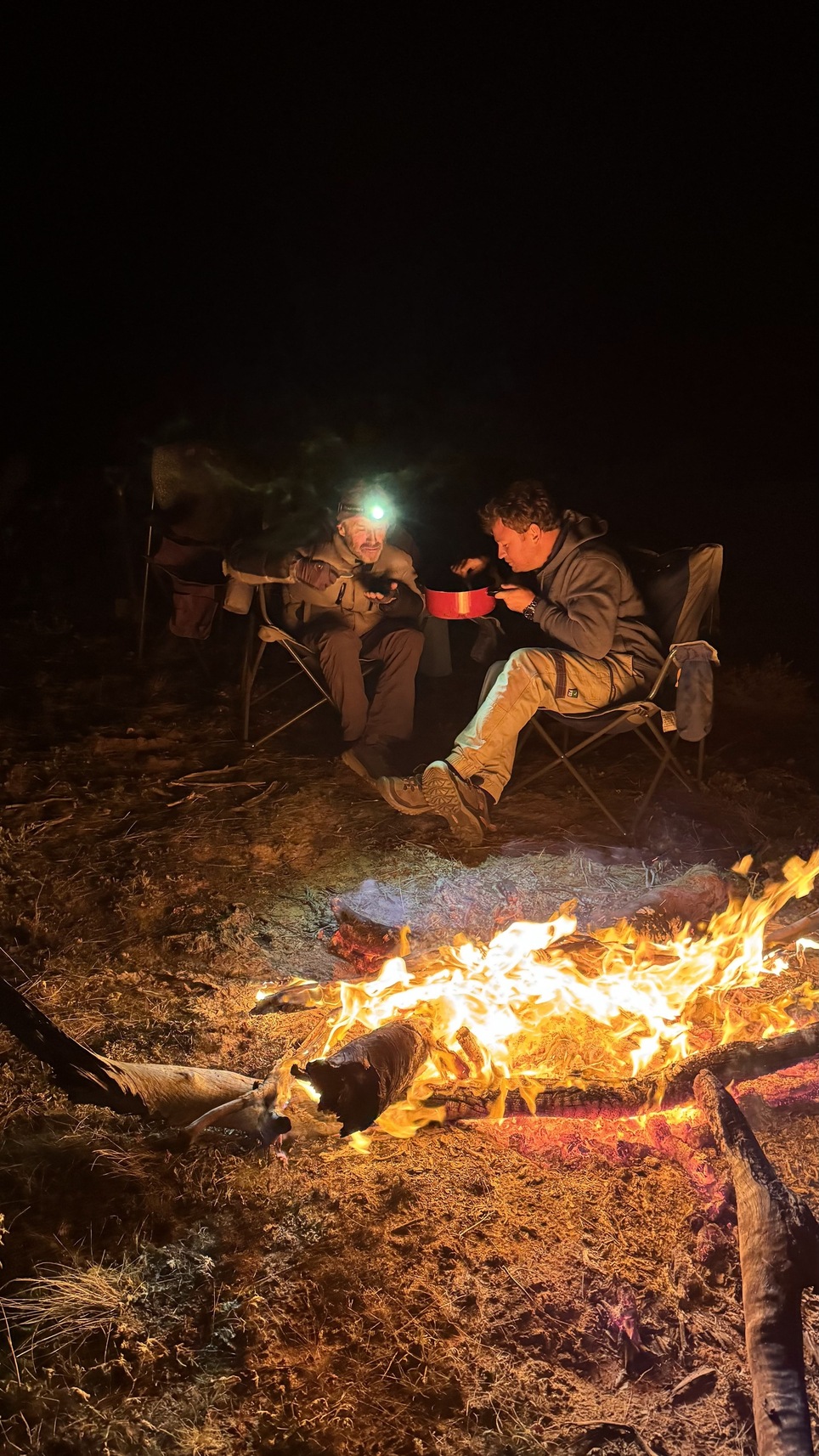
Alarms are set so everybody is ready for a 6:50 briefing, before moving out at 7.
The fire still a bit hot motivates the team to get out of the swags, Mia has already boiled some water, so we enjoy a nice cuppa waiting for the sunrise.
We pack gear for the morning and shortly after 7am we head out on foot on the edge of the lake. We have ~15km of walking ahead of us,
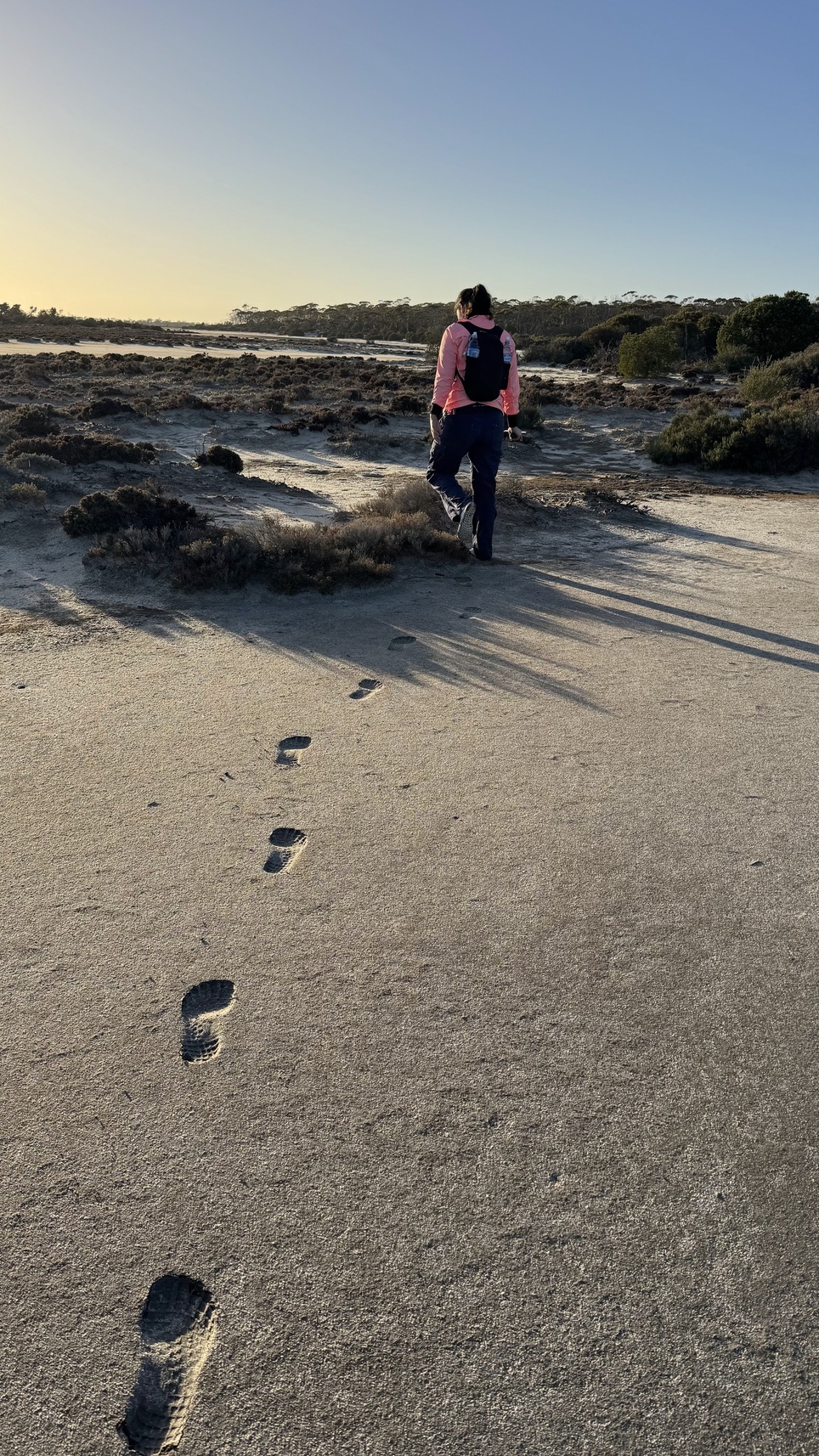
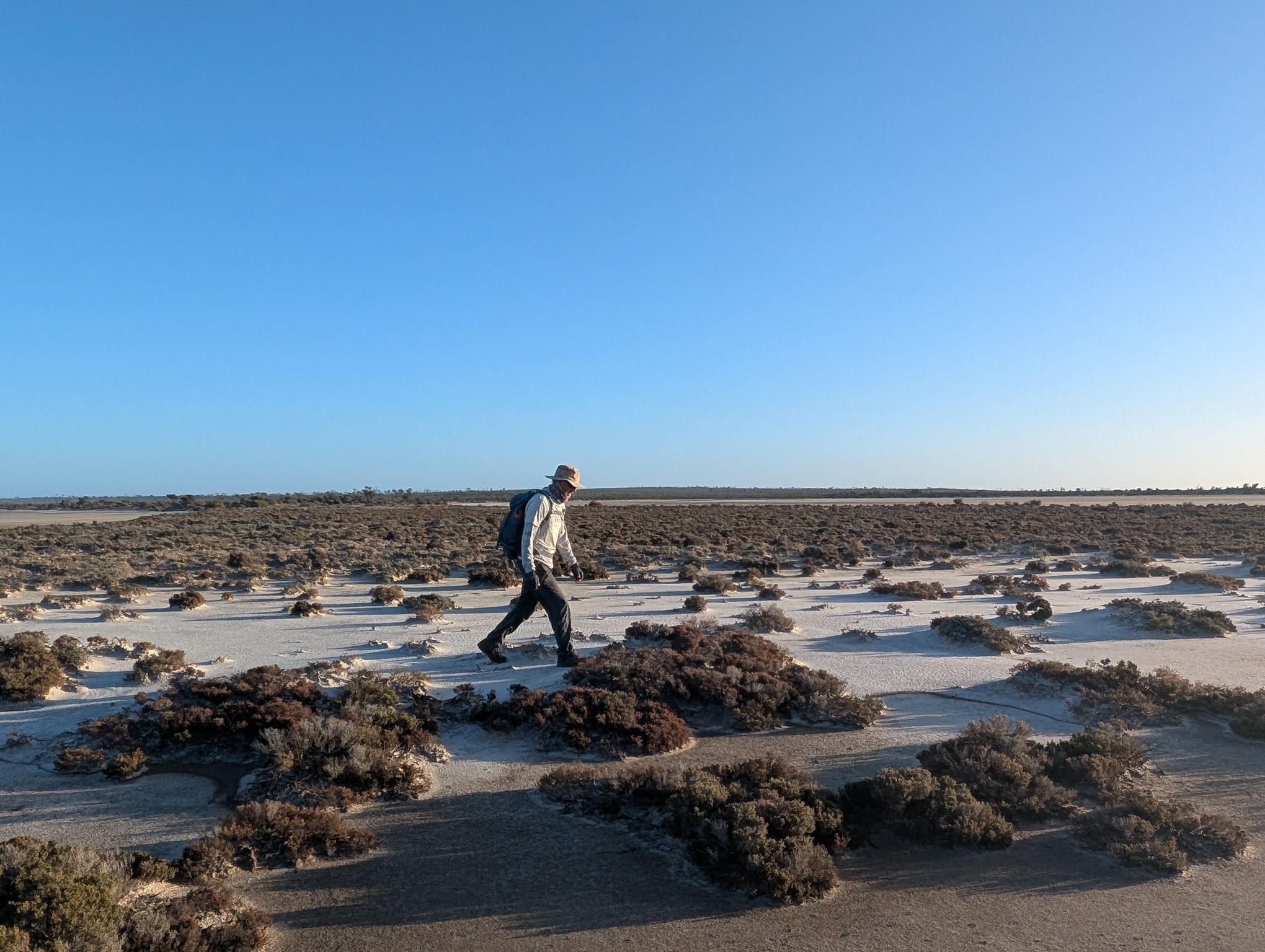
After about 5km, we stop so Mia can launch the drone. Ellie spotted an extra point of interest located some distance off our nominal route. We try to identify it with the drone camera, but no luck. So we decide not to detour ourselves on the way to the main targets, but instead visit the spot where Marcus found his meteorite.

We have another 1.5km before the first real target. The first one was the least convincing of all three, and turned out to be just a branch. But as we near the next one, Mia steadily picks up the pace, to a point where nobody can keep up with her!
And Mia has found a meteorite!
I decide to wash the meteoite. Normally not ideal as a sample curation practice, but it can’t be worse the staying in the salty muddy brine. We then place this one in a teflon bag, and also sample the lake using the beach shovel I borrowed from my kids :).
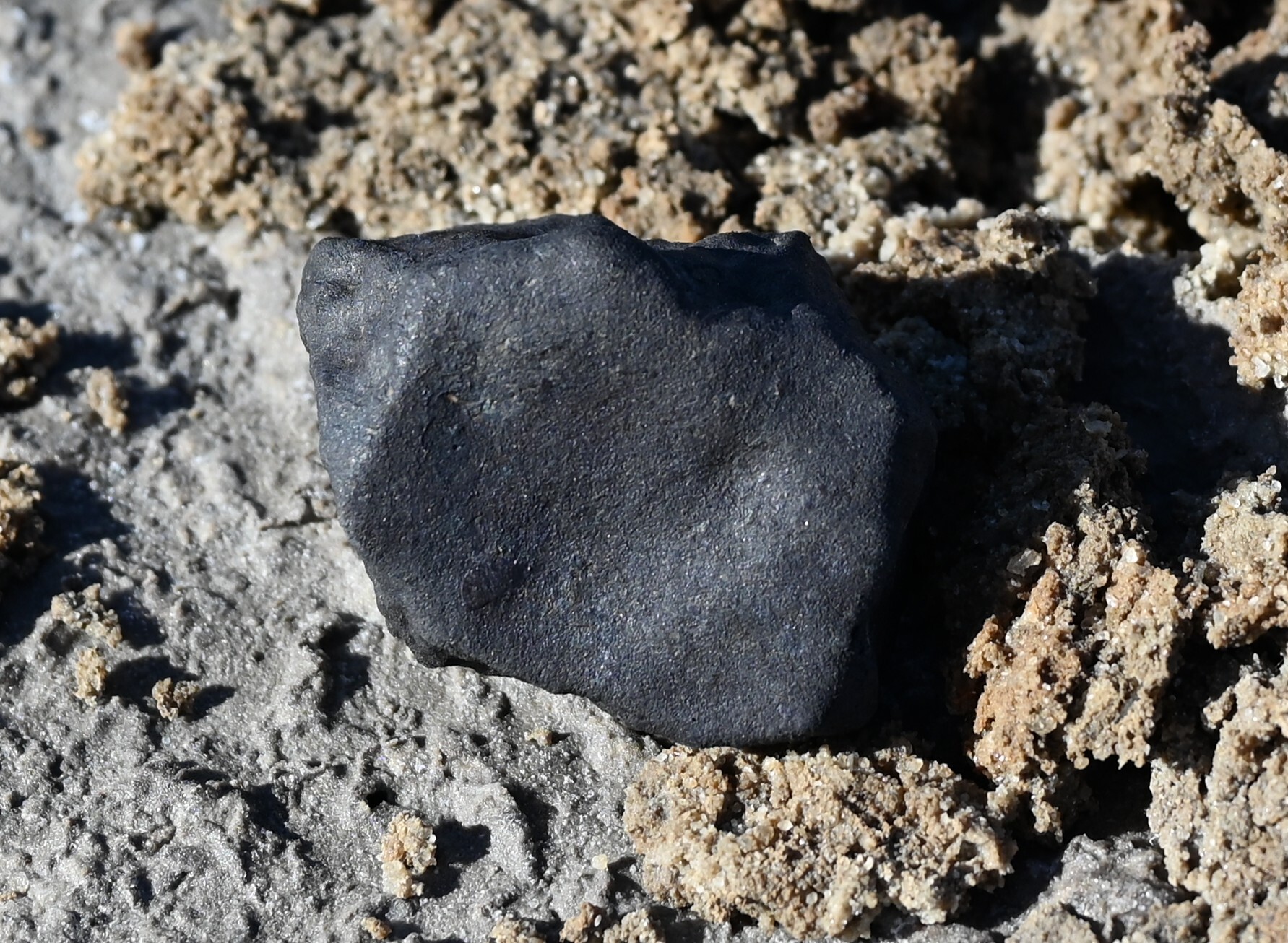
Soon enough it is my turn:
The whole team is over the moon! The TV crew relieved that we have found something at all.
We aslo wash this one, and bag it in aluminium foil.
It’s interesting seeing the differences between the three rocks that we collected so far: Marcus’ find fragmented on impact, but Mia’s and I’s remained intact, having hit softer spots.
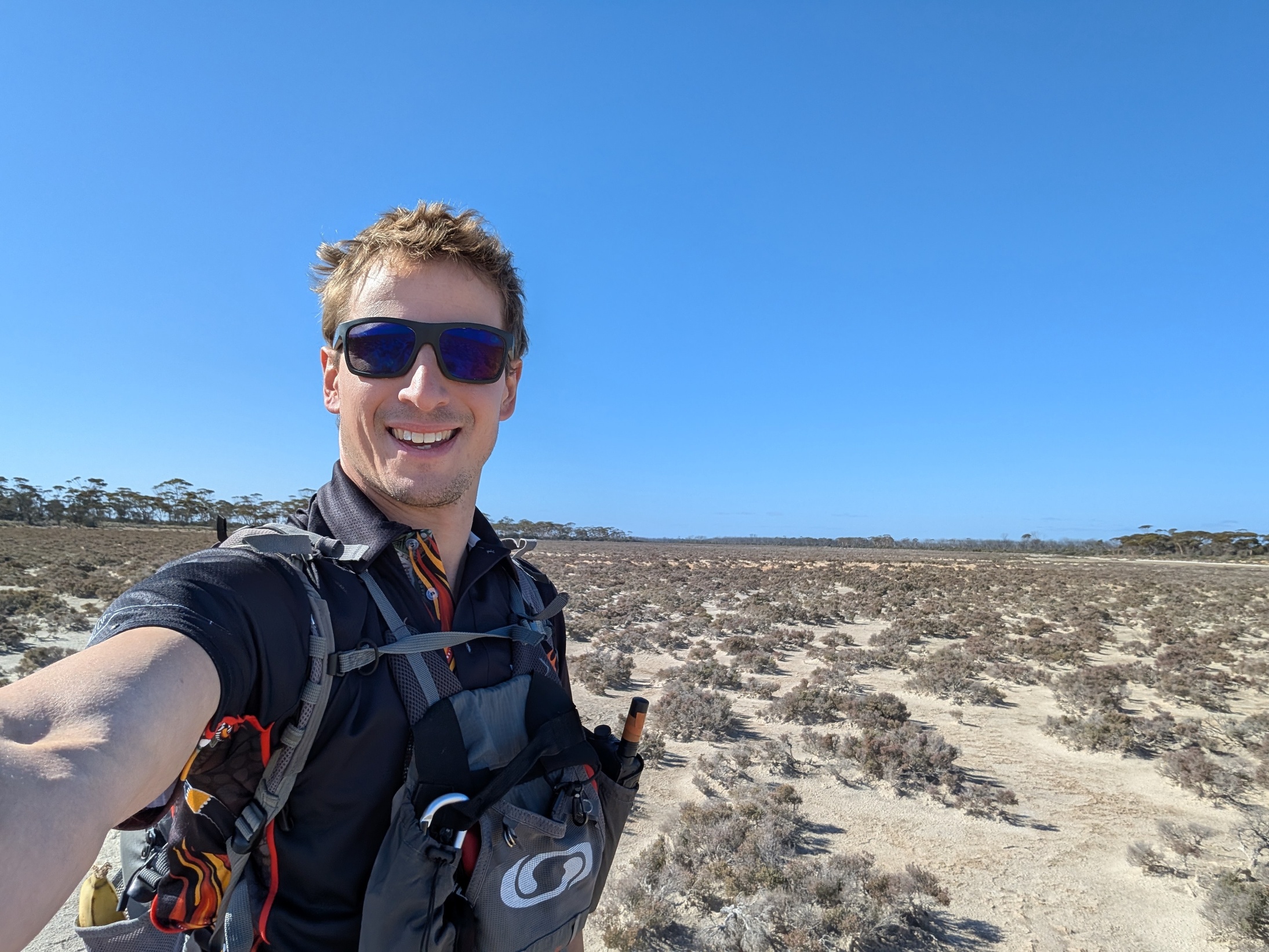
We try to return on a slightly different route to maximise chances of finding another piece, but no luck. The bush in between the lakes is very thick, impassable in places, I can’t believe our luck that some of the fragments hit the lake!
That walk back feels quite long. With the cars parked on a small ridge, we can see them from 4.5km away, we are still 45’ away from reaching them. By now the sun is high, the wind has picked up,
We reach them shortly after 12. Total: 16km covered on the lake in just over 5h. That’s a seriously impressive average, considering how long we stopped at the meteorites, and especially for Rhys who was carrying all the camera gear! What amazing team I was lucky to travel with!
Sometimes TV crew can ask to re-act a specific thing for 100 times, I was a bit worried originally as we were on a tight schedule. But Amber and Rhys nailed it, they grabbed everything in one shot, and their piece on TV looks great!
The drive out, after we had cleared the trees, was pretty quick, 1.5h to cover the 50km that take us back to the Hyden-Norseman road.
Back in Hyden we meet Marcus, who brings us his meteorite pieces. What a legend, he drove all the way up from Raventhorpe to meet us! We share stories about our incredible adventures, and very soon it is time for us to drive towards the setting sun back to Perth.
I sometimes worry when things go pretty much following plan A, wondering what the universe has got in store… But everything worked so well on this trip: the people, the weather, and we achieved total mission success with the meteorites!
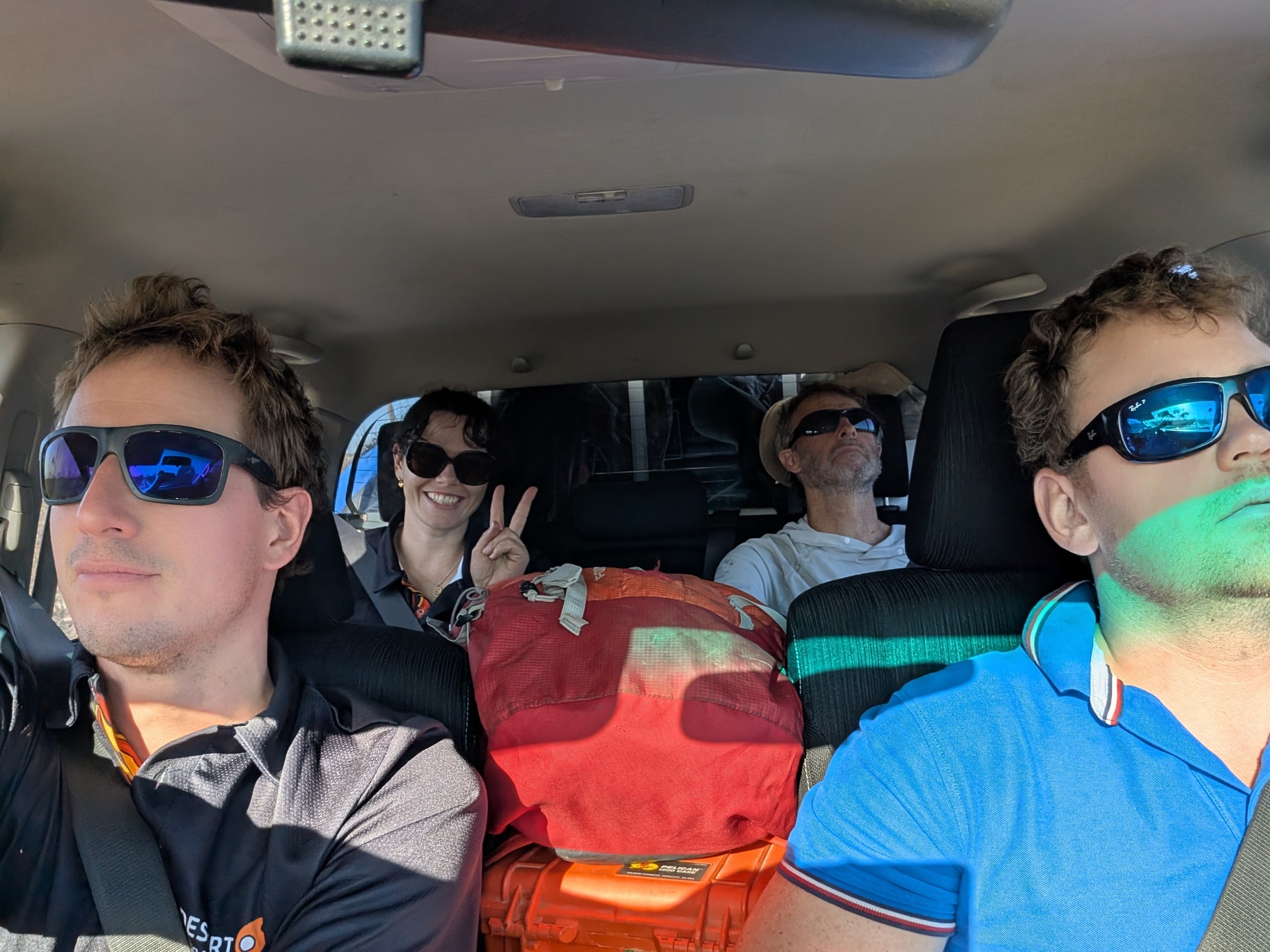
Part IV: Search Follow-up
by: Sophie Deam and Thomas Stevenson
Hi all, Sophie and Thomas reporting from Curtin University! We’ll wrap up by taking you through the final adventure (for now).
Day 1
Two weekends after the impact, a team of 4 of us went back to the fall area for a foot search. We accompanied Dr Andy Tompkins and Dr Rachel Kirby, veteran meteorite hunters from Monash University in Melbourne. Our goal was to search on the wide open areas of the salt lake for a meteorite, and the sparse scrub on its edges. We hoped to find another meteorite; fresh and preferably not in contact with the corrosive salt.
We set out from Perth on Saturday morning towards Hyden, on a warm day with blue skies. We drove on tarmac and dirt track until around 2pm, when we found our destination! Which was a totally unremarkable section of the track. We parked the car and set off on foot through the fall area. Eyes peeled, we tracked through many small clearings, bashed through prickly bushes, and skirted the edges of muddy lake beds.
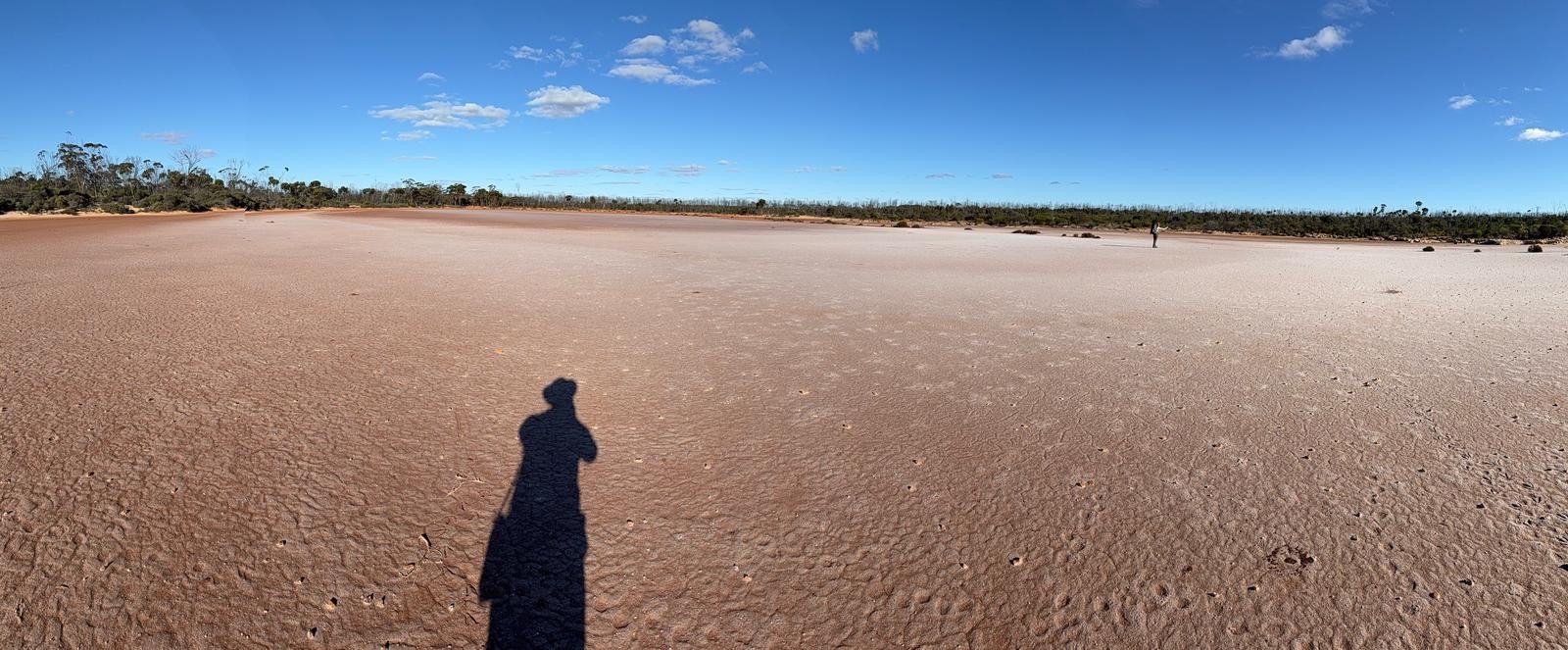

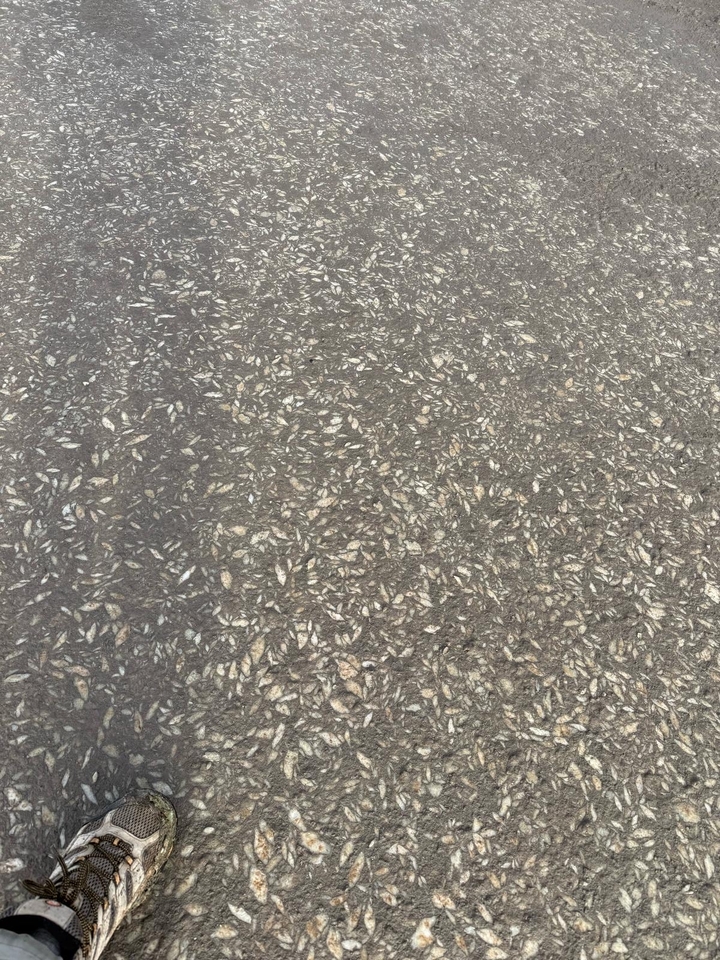
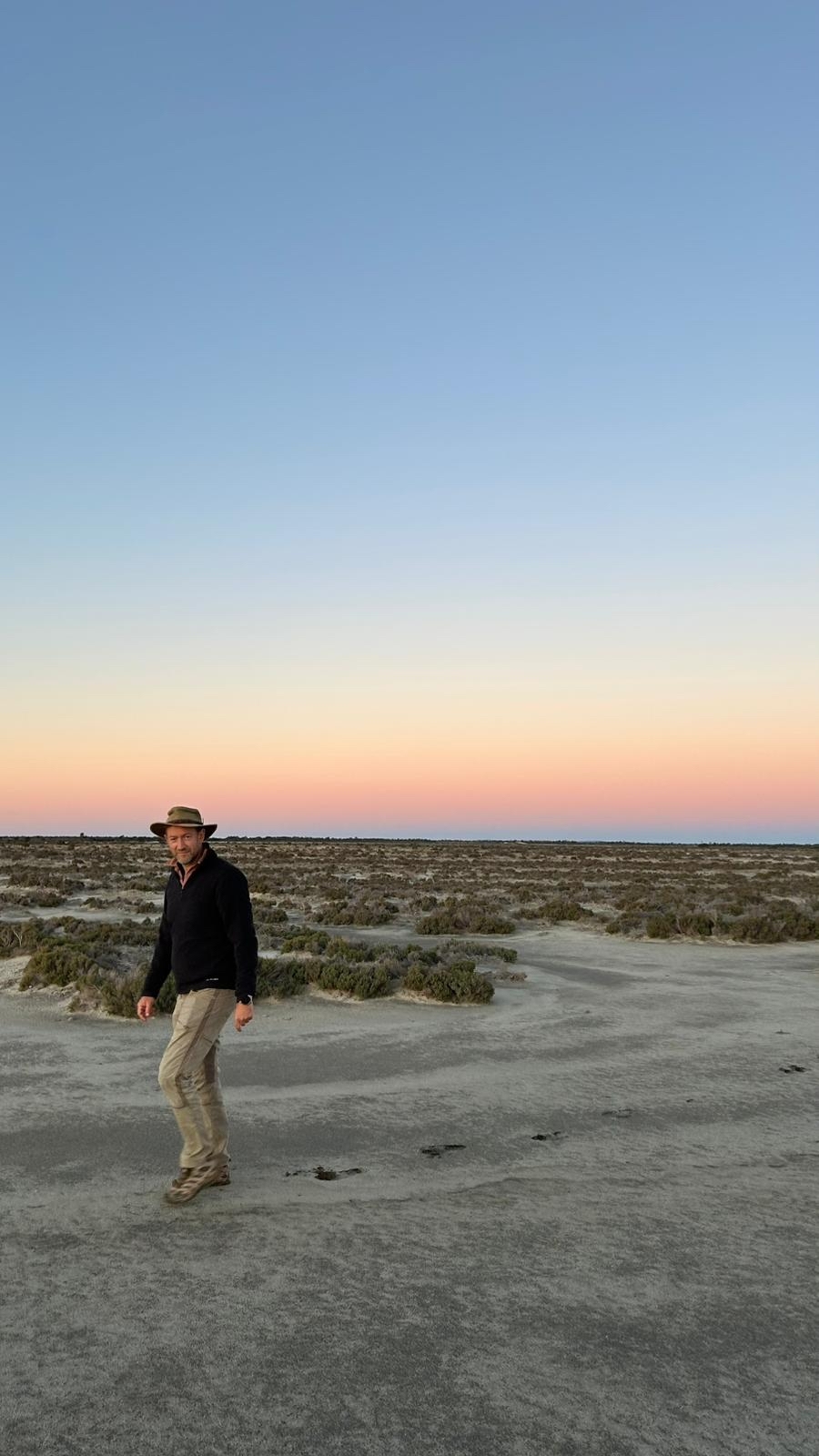
We made camp at sundown, precisely 3 km from the car, and enjoyed some hot food under the stars. As both of us are from New Zealand (the usual brain drain story), we were shown the Emu in the night sky by our Australian hosts. It is marvellous! Despite seeing photos of it many times, it is not always easy to know where to look. We also spotted a meteor streaking across the sky. Sophie and Rachel exclaimed ‘Wow’, to which Andy replied, “Awwwww, I missed it didn’t I?”. Thomas wondered if it might be a leftover bit of the asteroid that brought us the Mother’s Day meteorite. After some story telling and banter, we tuckered up in our tents for a chilly, but not too cold night.
Day 2
We woke to a warmer-than-expected morning, with slight movement in the air preventing any frost. “A slight breeze, no frost, that’s great!”, I (Sophie) thought. We shared some morning coffee and packed up our tents. Little did we know, it was about to get a fair bit breezier…
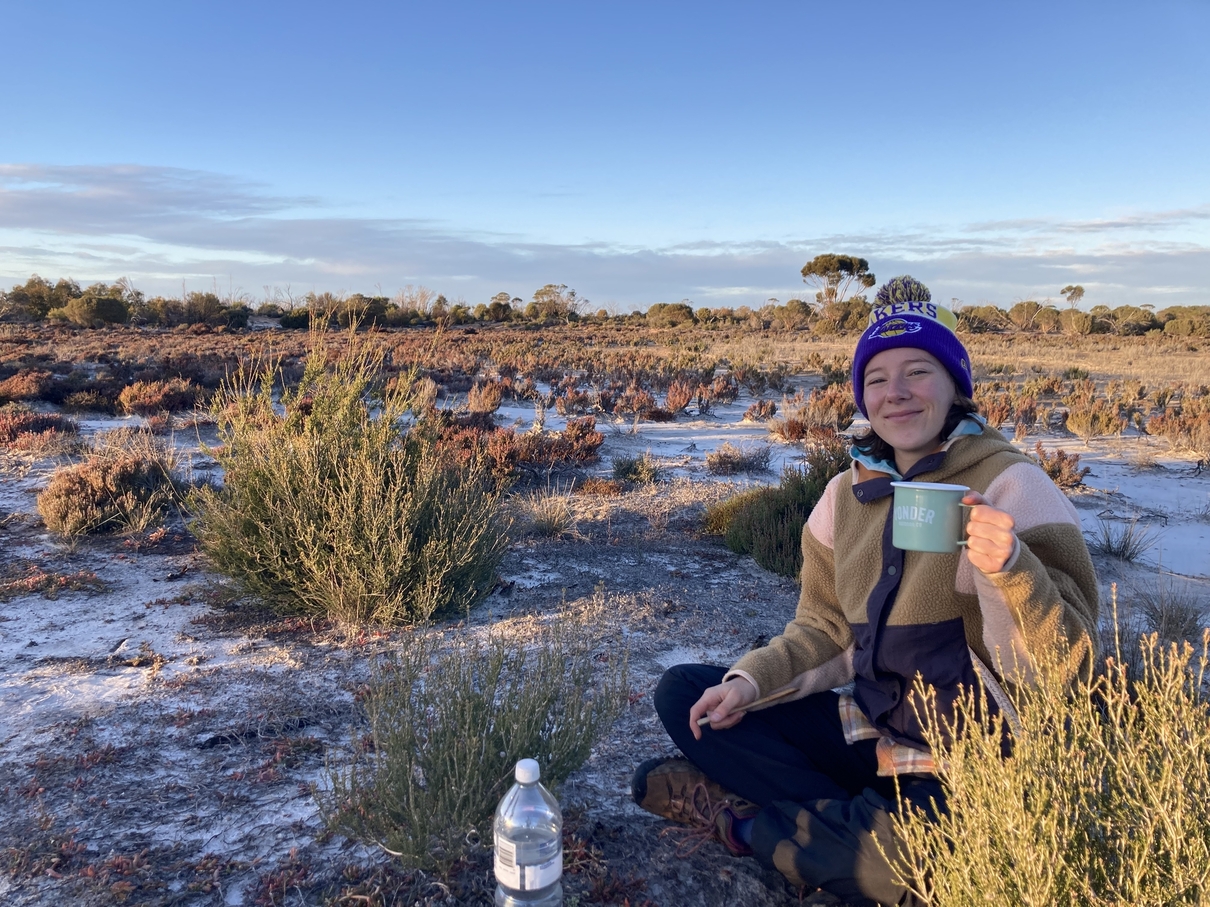
With GPS trackers and radios on, we spent the morning in two teams searching the nearby lake beds. On and on we walked, while watching ominous grey clouds gathering in the distance. Having never walked on a salt lake before, we quickly noticed some unique and interesting features of this environment. The salt itself contains gysum, which is as hard as chalk, and the whiter the surface is, the easier it is to cross. Browner patches, despite having a rocky texture at first glance, proved to be much softer and stickier. There were also localised patches of reddish mud resembling pan brownies, and dry streambeds full of deceptively meteorite-shaped pebbles. This varied terrain, the flatness of the horizon and the lack of visible landmarks made for an incredible and slightly eerie experience.
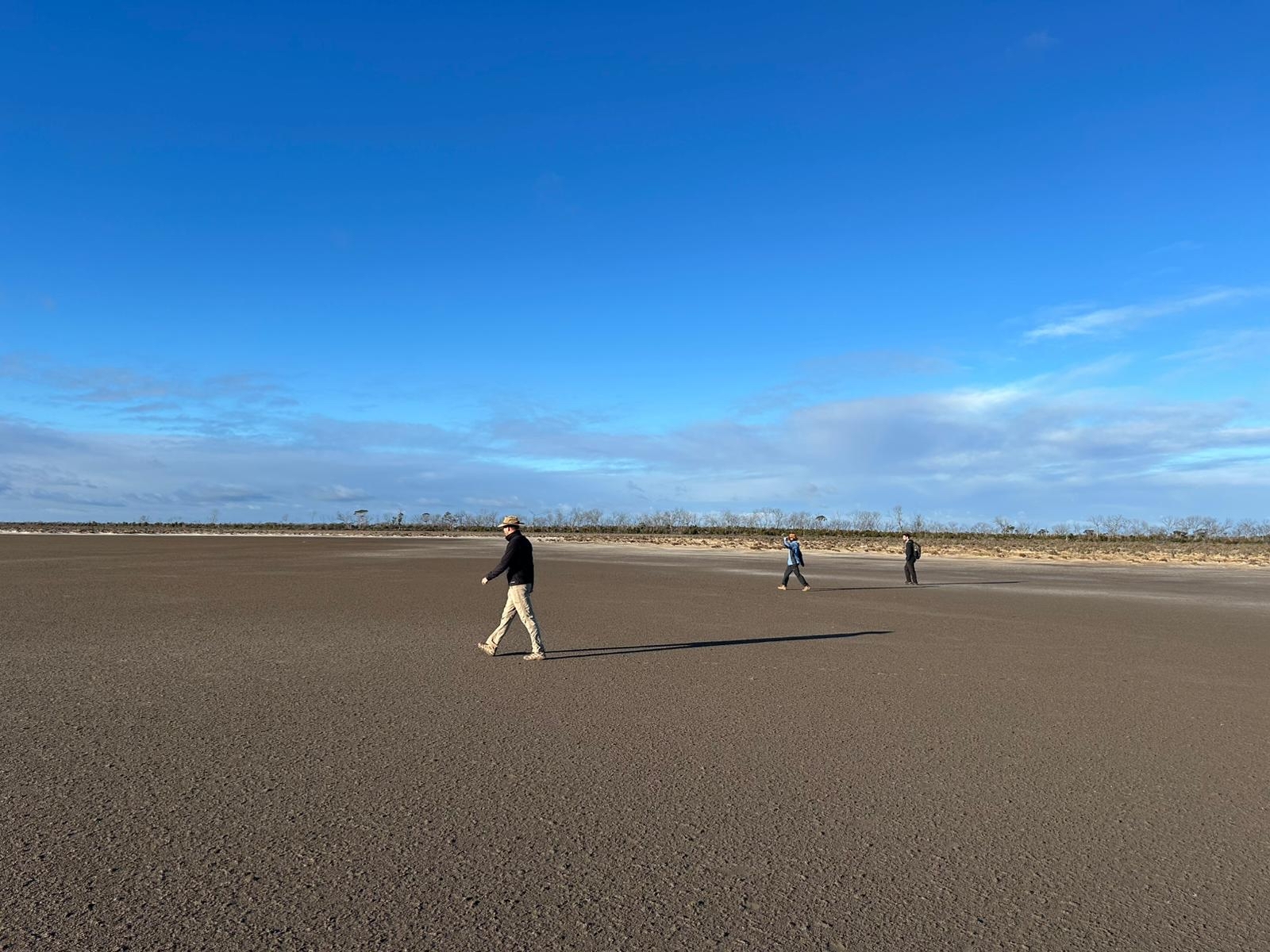
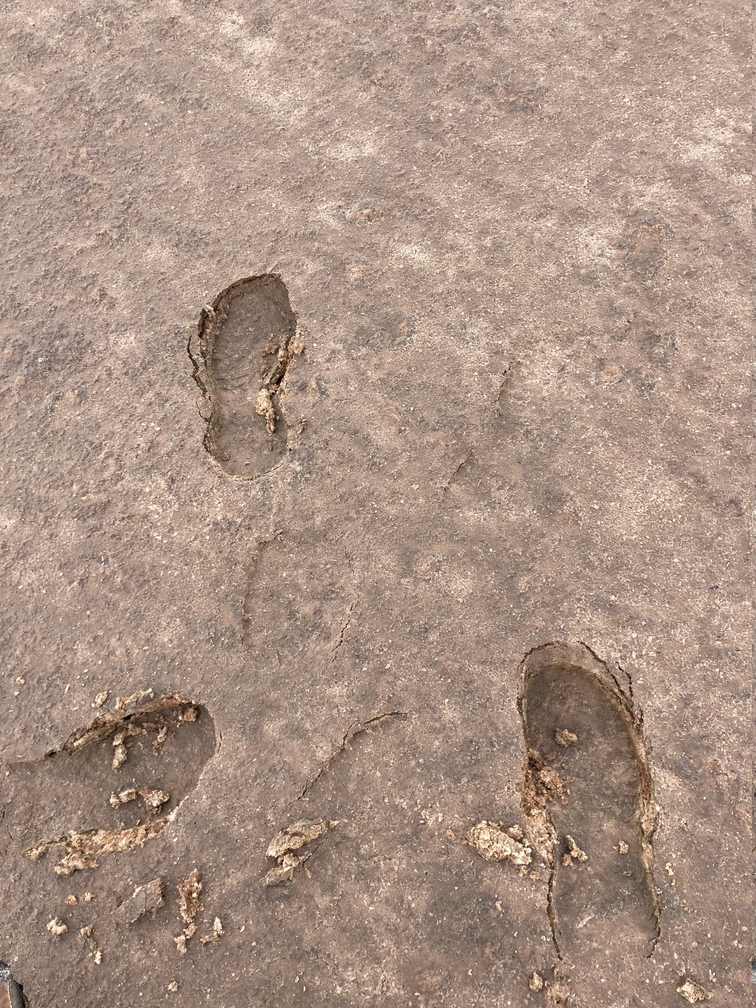
The wind picked up as the morning went on, and soon we noticed how much harder it was to walk in one direction, and easier the other way with the wind and drizzle at our backs. In other words, a normal day over the Tasman Sea. Each time the radio sounded, we hoped for news from the other team of finding a meteorite. One message from Rachel sounded like “Andy’s got one”, but the crackle had distorted the sound. It turned out to be a false alarm.
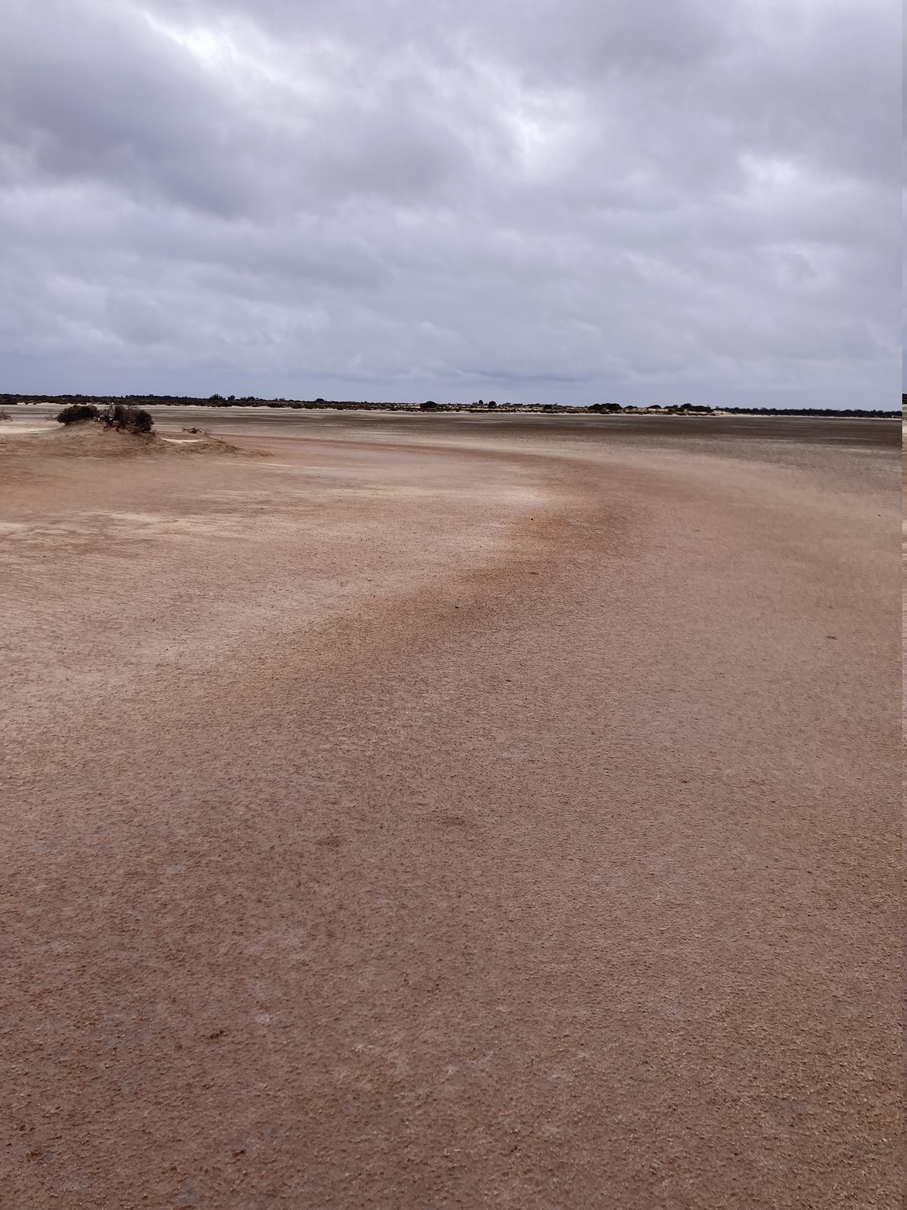
We finished our search with no meteorites in hand, but with a better idea of the conditions for this section of the fall site. A smooth trip overall, and we can’t wait for another chance to return and keep hunting!
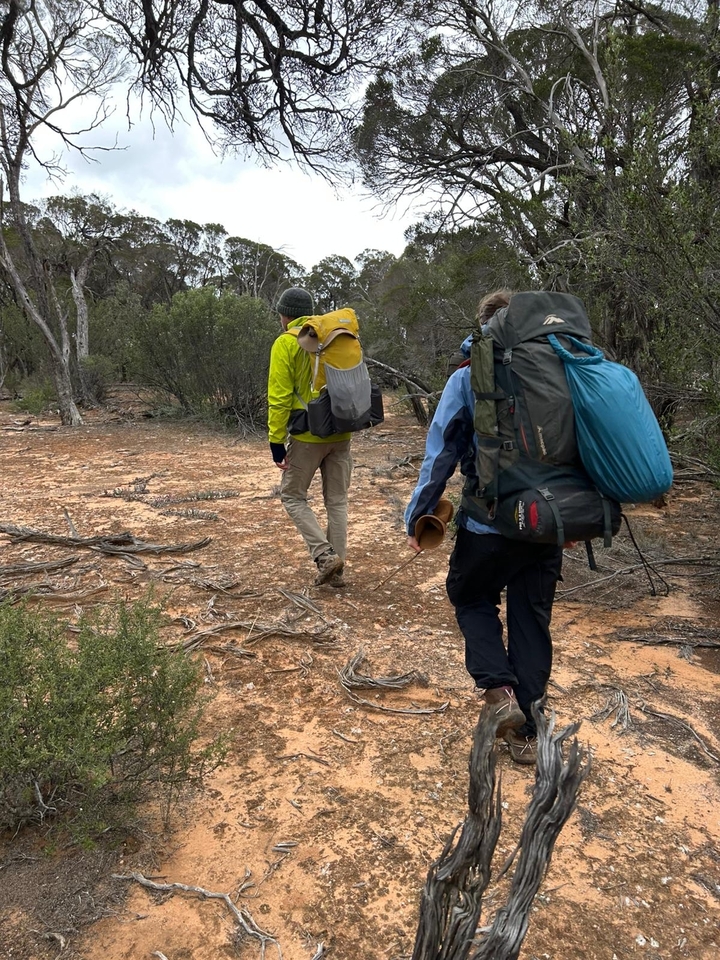
Part V: Back in the lab
We have started analysing the rock, sharing samples with the global meteorite analysis consortium. Stay tuned!
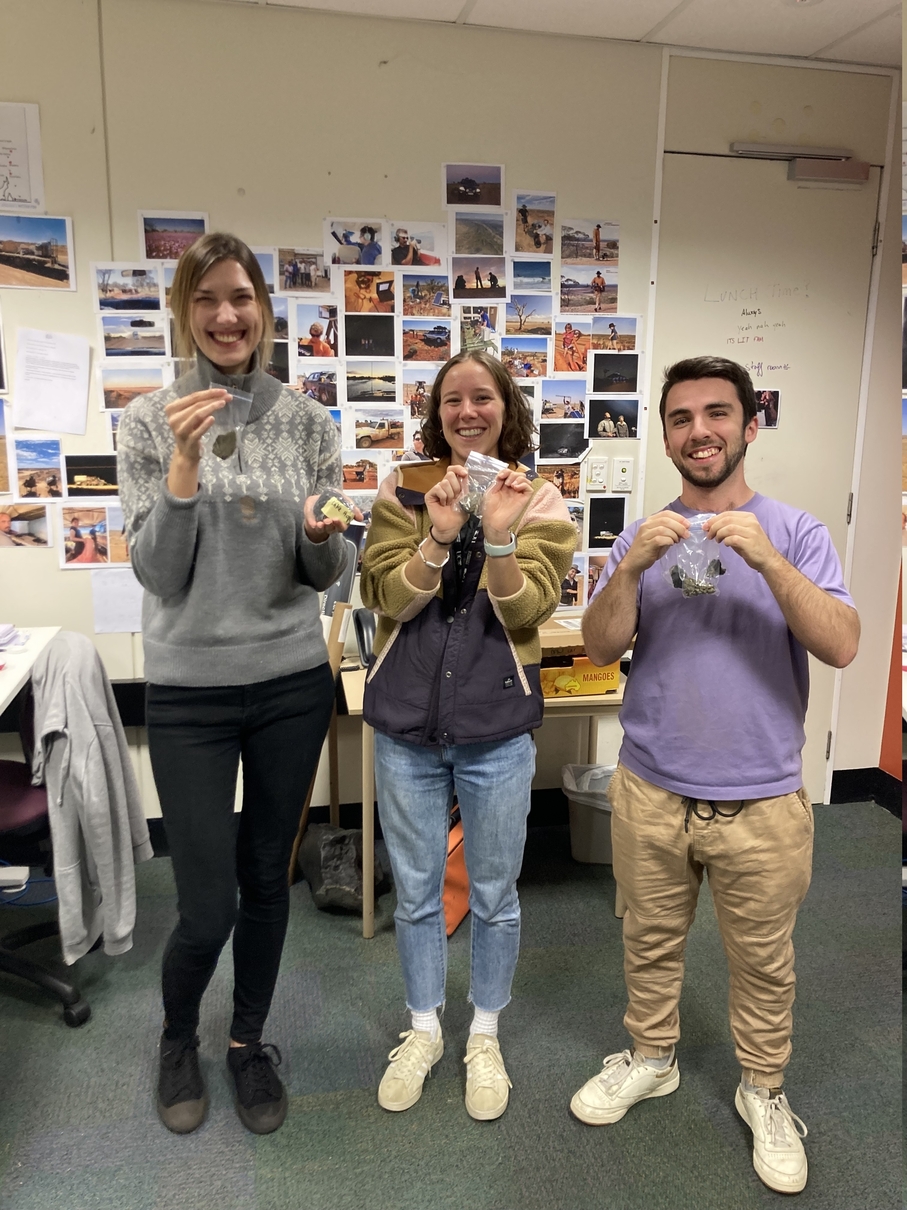
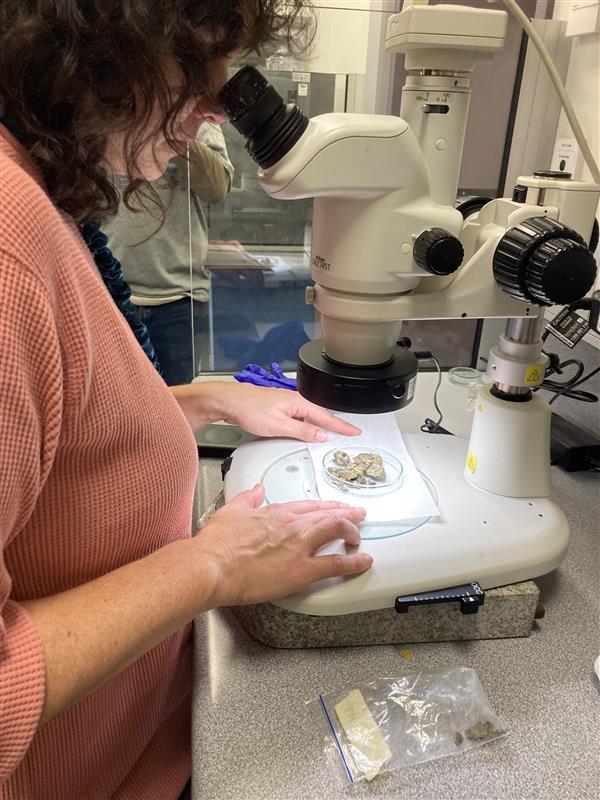
We hope that in a couple of weeks time, people will be able to come see one of the stones exhibited at the WA Museum.

